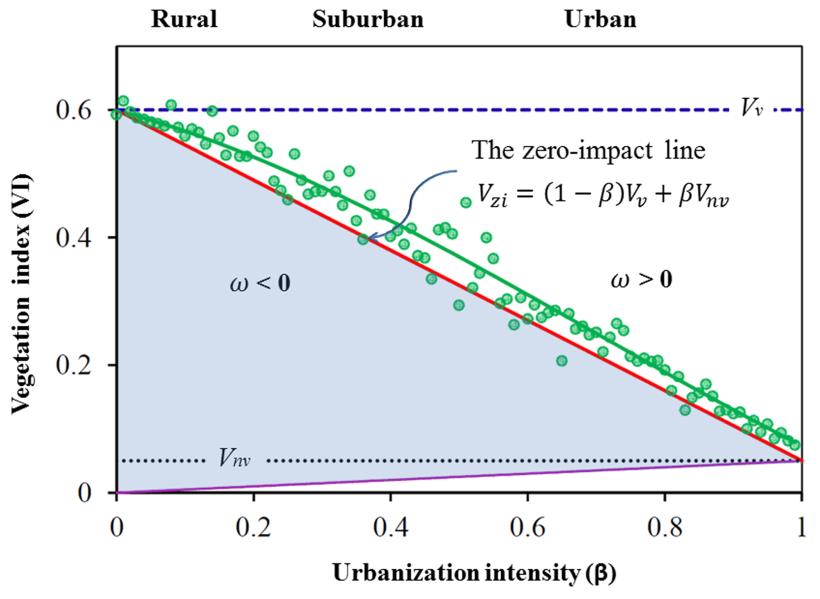PNAS:北京大学赵淑清团队发表城市环境大规模增强植被生长研究
近日,国际著名学术期刊《美国国家科学院院刊》杂志在线发表了北京大学城市与环境学院赵淑清研究团队的一篇研究论文,论文提出了一个评估城市化对植被生长影响的理论框架体系,并将其应用到中国的32个大型城市,研究结果题为《城市环境大规模增强植被生长》。
理解植被对未来气候和大气成分变化(如温度增高、CO2浓度上升等)的响应是预测未来全球气候、碳循环、植被生产力等变化的关键。控制实验(如增温、CO2浓度加倍等)适用于微观到生态系统尺度的植物响应模拟和观测。且控制实验的环境条件对植物而言往往是突变(如CO2浓度突然增加一倍),其响应特征可能与天然渐变环境下的响应不同。迄今为止还没有关于气候和大气成分变化在较大空间尺度上对自然状态下植被影响的报道。
城市热岛效应明显、CO2浓度显著增高、活性氮化物增加,这些城市环境变化比自然生态系统未来将出现的平均水平提前几十年。所以城市环境被认为是全球变化的“先驱”(Harbingers),是全球变化研究的“天然实验室”,尤其是了解自然生态系统对于未来全球环境变化的潜在响应。
城市化进程中不透水表面(如道路、建筑物等)替代部分植被,导致城区植被面积减少;同时,前面提到的城市环境条件可能会促进城市植被生长。对于城市化如何直接和间接影响植被的认识相对有限,更缺乏较大空间尺度上的定量研究。
评估城市化对植被生长影响的理论框架体系是基于植被生长状况沿城乡城市发展强度(β)从0(没有城市化)到1(完全城市化)的变化而建立的(见图)。大量研究表明植被生长状况可用卫星遥感数据如MODIS evi植被指数产品替代指示,而每一个城市地块的EVI是其植被EVI和不透水表面EVI的综合。
将这一理论框架应用于中国32个城市发现大约85%的城市植被显示城市环境对其生长有促进作用,而且这种间接促进作用大约可以抵消40%的城市化对于植被替代的直接负面影响。当然,其它约15%的植被生长没有增强或者有所降低。这项大数据研究结果与全球为数不多的地面样地实测报道吻合。
这项研究成果在尺度上和方法上对全球变化研究具有指导意义。在尺度上,将以往模拟控制实验的实验室或样地尺度拓展到了景观乃至全球尺度;在方法上,用遥感技术研究植被在自然状况下对全球变化的整体响应,弥补了以上提及的控制实验存在的不足。

沿城乡梯度城市化对植被影响的理论框架体系。Vv和Vnv分别是乡村或潜在植被和没有植被覆盖城市地表的植被指数状况。绿色的点和绿色的线是沿城乡梯度实际的植被指数状况和拟合线,红色斜线是城市环境对植被生长没有影响的零影响线。零影响线之上的点表明城市环境对植被生长有促进作用,零影响线之下的点表明城市环境对植被生长有负面影响。
原文链接:
Prevalent vegetation growth enhancement in urban environment
原文摘要:
Urbanization, a dominant global demographic trend, leads to various changes in environments (e.g., atmospheric CO2 increase, urban heat island). Cities experience global change decades ahead of other systems so that they are natural laboratories for studying responses of other nonurban biological ecosystems to future global change. However, the impacts of urbanization on vegetation growth are not well understood. Here, we developed a general conceptual framework for quantifying the impacts of urbanization on vegetation growth and applied it in 32 Chinese cities. Results indicated that vegetation growth, as surrogated by satellite-observed vegetation index, decreased along urban intensity across all cities. At the same time, vegetation growth was enhanced at 85% of the places along the intensity gradient, and the relative enhancement increased with urban intensity. This growth enhancement offset about 40% of direct loss of vegetation productivity caused by replacing productive vegetated surfaces with nonproductive impervious surfaces. In light of current and previous field studies, we conclude that vegetation growth enhancement is prevalent in urban settings. Urban environments do provide ideal natural laboratories to observe biological responses to environmental changes that are difficult to mimic in manipulative experiments. However, one should be careful in extrapolating the finding to nonurban environments because urban vegetation is usually intensively managed, and attribution of the responses to diverse driving forces will be challenging but must be pursued.
作者:赵淑清

